
2013 International Aluminum Extrusion Design Competition
Student Class Winning Entries

The 2013 Aluminum Extrusion Design Competition was very successful with more than 90 entries received from students around the world. The Aluminum Extruders Council (AEC) and the ET Foundation would like to thank all of the students who submitted designs for the competition and the instructors for supporting the Aluminum Extruders Council’s Academic Outreach program by incorporating the competition into their class curriculum.
A total of 13 students received recognition for their designs using aluminum extrusions. Scholarship awards for First, Second, and Third Place, as well as the Sustainable Design were presented. In addition, the judges found more designs deserving of recognition and decided to present additional awards. A total of $11,250 in scholarship awards in the form of cash prizes will be presented to the winning students.
1st Place: Solarboard by Dominic Atibil from Purdue University
2nd Place: Light in Case of Power Failure by Jasnic Milan from FUD Megatrend, Belgrade, Serbia
3rd Place: Two-in-one Collapsible Stretcher by Dajing Li from Purdue University
4th Place: AirLam by Ryan Krauskopf from Purdue University
5th Place: Architect by Christopher Capen from Purdue University
Sapa Sustainable Design: Refugee Tent by Nicolas Desjardins from Dawson College, Westmont, Quebec, Canada
Sapa Sustainable Design Honorable Mention: Focal Water Purification System by Cameron Sweeney from Purdue University
Sapa Sustainable Design Honorable Mention: Solarboard by Dominic Atibil from Purdue University
Honorable Mention: Capture Cane by Chloe Condon from Purdue University
Honorable Mention: Custom Contour Furniture by Robert Jewett and Atniel Quetz from Andrews University
Honorable Mention: Essuye by Jessica Novitski from Purdue University
Honorable Mention: Inculta Bench by Zvezdan Nedelinovic from FUD Megatrend University, Belgrade, Serbia
Honorable Mention: REwater-mill by Gorana Nesic from FUD Megatrend University, Belgrade, Serbia
Cash awards and scholarships for the 2013 Aluminum Extrusion Design Competition sponsored by:

Sapa Extrusions North America, Exclusive Platinum Sponsor

Almag Aluminum Inc., Silver Sponsor
*Click on the thumbnail of each image to be taken to the larger, higher-resolution image*
1st Place
$3,000 Scholarship Award
"Solarboard"
Dominic Atibil
Purdue University
West Lafayette, Indiana
The Solarboard is a semi-permanent solar-powered bulletin board for outdoor use in both urban and rural settings. "It harnesses the power of the sun and powers LED lights to illuminate the posters on [the] bulletin board, as well as provides minimal security lighting in the night time," wrote Dominic Abitil in his entry materials.
The judges liked the design because of how it incorporates the use of eco-friendly aluminum along with solar power and LED lights. "I can see it on bike paths, in parks, and so on," said Design Competition judge Todd Boyer, Director of Sales and Marketing at Mid-States Aluminum in Fond du Lac, Wisconsin. "The design is really a snapshot of life today. It's self-sustaining and shows off the use of aluminum in a solar and LED lighting application."
"The Solarboard is intended for outside use so aluminum was chosen as the material for the extruded parts because of its anti-corrosive properties. The ease of finishing is a manufacturing advantage of aluminum extrusion that lowers manufacturing and finishing costs," noted Abitil. "The heat conductive properties also allow incorporation of heat sinks into the shape."
The student also won a $250 Sustainable Design Honorable Mention Scholarship Award for his design.
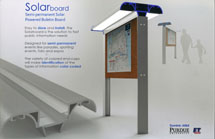 |
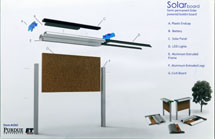 |
Second Place
$2,000 Scholarship Award
"Light in Case of Power Failure"
Jasnic Milan
FUD Megatrend
Belgrade, Serbia
This design was created as a new or retrofit lighting system for existing buildings to provide illumination during a power failure for stairways and other dark areas of buildings. According to the student, the system works automatically; the controller detects when power fails and switches on the LED lights powered by batteries. "This design points the way to similar applications for existing handrails with these features built in" suggested competition judge Craig Werner, principal at Werner Extrusion Solutions LLC in Libertyville, Illinois. "The market for this application is huge."
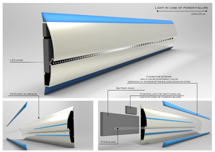 |
 |
Third Place
$1,000 Scholarship Award
"Two-in-one Collapsible Stretcher"
Dajing Li
Purdue University
West Lafayette, Indiana
Dajing Li, a sophomore Industrial Design student at Purdue University,used aluminum for the design of this emergency medical stretcher for its light weight, durability and corrosion resistance. It is designed as a separate nylon fabric stretcher and foldable extruded aluminum cart. "The purpose of this design is to enhance security as well as the [stability] of the stretcher," explained Li referring to the S-shaped inner protective pieces at the four corners of the structural tube. The pieces prevent the stretcher from moving in order to make the patient feel "as comfortable as possible during transportation. The [ease] of folding and unfolding the stretcher can save time for medical workers and meanwhile save precious time for the patients," explained Li.
The judges appreciated the design for its dual-purpose and well-engineered use of aluminum extrusion. "It's simply fabricated and joined to excellent utility," explained competition judge David Asher of Bonnell Aluminum in Newnan, Georgia.
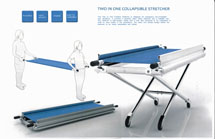 |
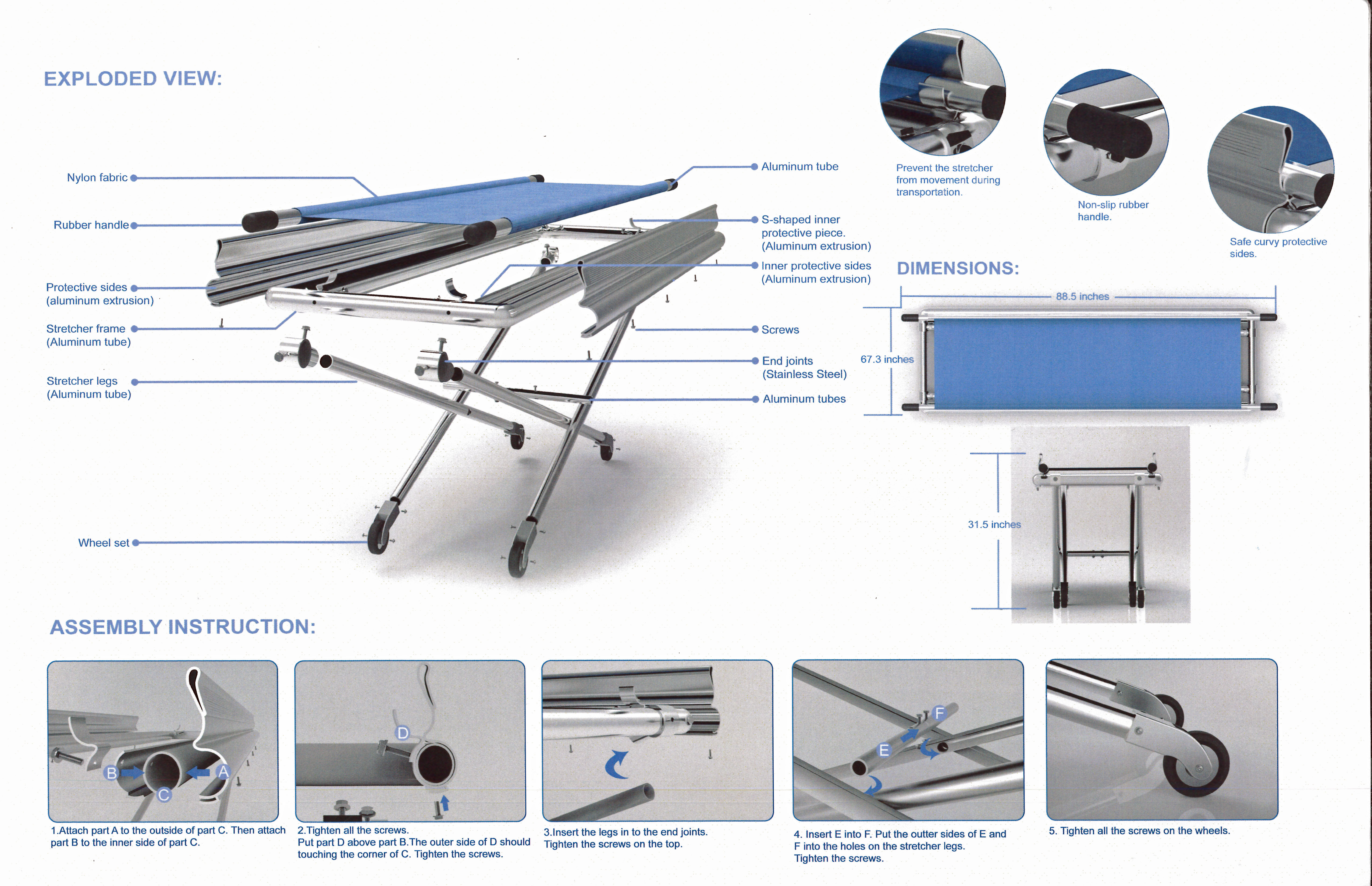 |
Fourth Place
$750 Scholarship Award
"AirLam"
Ryan Krauskopf
Purdue University
West Lafayette, Indiana
AirLam is designed to be a "sleek, safe, efficient, unobtrusive climate control system," according to RyanKrauskopf, a sophomore studying Industrial Design at Purdue University. AirLam's extruded design allows it to be used in a myriad of locations from cramped RV's to large open rooms of up to 400 square feet. Uniform extruded components allow many different lengths to be produced from the same tooling, saving production costs. Aluminum's excellent heat conductivity, light weight, resistance to the elements allow this system to be utilized nearly anywhere.
The system uses convection heating to move the air, thus requiring no external duct work, only a connection to a grounded three-prong outlet. "This makes it the perfect solution for locations requiring large-scale climate control, but where a series of ducts and vents are implausible, [such as] boats, RVs, cabins, and older structures," explained the student. The system can be "used to supplement full scale heating in the winter and reduced air conditioner usage in the warmer months."
The extensive use of extrusion, fabrication and anodizing, as well as its marketability were the reasons that this design was recognized with an award. "I wish my boyhood home with baseboard radiant heat had this system!" said Werner.
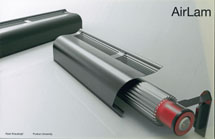 |
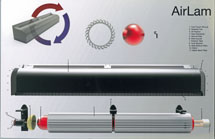 |
Fifth Place
$500 Scholarship Award
"Architect"
Christopher Capen
Purdue University
West Lafayette, Indiana
"Anyone who has ever started a home DIY project, or has been to a construction site can tell you that a lack of space is more than just frustrating; it can be a hindrance to the entire project. This is whereArchitect comes in," explains Christopher Capen, a sophomore studying Industrial Design at Purdue University.
Architect is constructed from durable, lightweight extruded aluminum parts and is held together with a combination of galvanized steel bolts and fasteners, ensuring that the system will never rust even in the harshest environments, the student wrote in his entry submittal. The built-in tracks along the case's surface can be used to mount tools or fasteners, align and secure parts or use the included side panels to add additional space. The height of the workstation can also be adjusted via four collapsible legs, which allow the system to be set up even on rough or uneven terrain. Converting from case to workstation is easy and requires only simple tools.
The judges liked the ingenuity of the design. "The case forms the work bench, it has substantial structure to it, and it marries aesthetics, strength and functionality," said Werner.
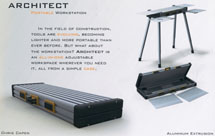 |
 |
Sapa Sustainable Design
$2,500 Scholarship Award
Refugee Tent
Nicolas Desjardins
Dawson College
Westmont, Quebec, Canada
The Refugee Tent concept from Nicolas Desjardins studying Industrial Design at Dawson College, is a multipurpose shelter and water collection/filtration system. The tents are constructed of aluminum extrusions, glass-reinforced ABS connectors, waterproof canvas and active carbon cloth. The stable structure and durable materials offer temporary living space and safe drinking water for refugees. "The tent can easily be assembled alone without tools thanks to two similar extrusion profiles that can easily slide into one another, [and] every component fits into a 55 gallon drum," explained the student. The drum is then used to collect the drinking water that drips from the carbon filter mounted on the structure’s roof.
"His concept for a basic shelter is simple and feasible, well designed in regards to fabrication costs, ease of field assembly, extrusion design, etc. and follows the spirit of the contest through its intended humanitarian applications and dual functionality as a shelter and rain water collection system," said Hedman. "The concept of fitting the shelter inside of a 50-gallon drum, which would later be used for water collection, was quite clever and practical. Nicolas' presentation materials show his deliberate thought and intention by referring directly to the competition's criteria."
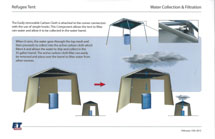 |
 |
Focal Water Purification System
$250 Sapa Sustainable Design Honorable Mention
Cameron Sweeney
Purdue University
West Lafayette, Indiana
Focal Water Purification System is designed "using the age-old process of a simple solar still, in what I believe would be a much more efficient and faster way [to purify water]," explained Cameron Sweeney. The system was designed to take contaminated water into a chamber that heats the water, which causes it to evaporate more quickly. The purified water vapor then gets deposited into the condensing container after passing through a heatsink which condenses the water into droplets. "I believe this has the potential to become a sustainable water supply for any area of the world that has a problem with clean water," Sweeney wrote.
"I think this design has some problems from a pure process/mechanics perspective, but he clearly was attempting to use extrusions effectively and had some neat concepts, such as the profile that holds a lens and integrates a heat sink to dissipate heat and cause evaporation of the water," said Hedman. "His design demonstrates a good understanding of extrusion concepts and some realistic applications of that knowledge. I also quite liked the integrated stake for fixing it to the ground and the pivot allowing the user to orient the unit towards the sun."
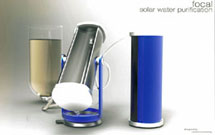 |
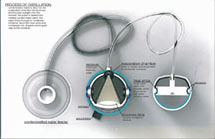 |
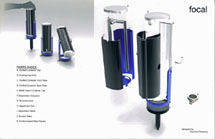 |
|
Solarboard
$250 Sapa Sustainable Design Honorable Mention
Dominic Atibil
Purdue University
West Lafayette, Indiana
Purdue student Dominic Atibil's "solar board" concept displayed good extrusion knowledge, though it is in need of breaking the design into multiple shapes. "I could see something like this actually being successfully commercialized. It checks the environmental box from an energy savings perspective," said Hedman.
(See First Place Award for complete description.)
Capture Cane
$250 Honorable Mention
Chloe Condon
Purdue University
West Lafayette, Indiana
"I wanted to create an entirely new product that uses aluminum to its best advantage," said Chloe Condon, a sophomore Industrial Design student at Purdue. The design, spurred by a family friend who Velcros her "easy grabber" onto her cane, combines the two into a completely redefined product. "The Capture Cane acts as a support while walking or standing, as well as grabbing when an item is out of reach," noted Condon. Extruded aluminum was chosen because it is durable, lightweight and strong.
The dual functionality of this clever design was a plus for the judges. "There is a huge potential growing market for this product with the elderly demographic in our society," commented Werner.
 |
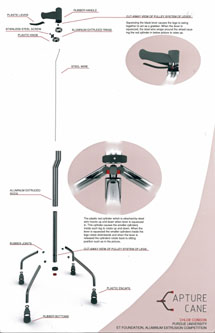 |
Custom Contour Furniture
$250 Honorable Mention
Robert Jewett and Atniel Quetz
Andrews University
Berrien Springs, Michigan
"The inspiration for this project came from the necessity to provide a product with simple manufacturing potential," noted students Robert Jewett, a junior studying mechanical engineering and Atniel Quetz, a senior studying electrical engineering at Andrews University, Berrien Springs, Michigan. The custom contour furniture is composed of many individual components, having the potential for an unlimited number of configurations for use outdoors or indoors. The students found aluminum to be "the perfect medium for a project of this nature because of its resistance to corrosion and pleasing aesthetic."
Although the parts need some redesign to make them "extrudable", the judges felt the students' design deserved recognition for the well-thought-out functionality of extrusion to create a system of parts that can be assembled into a variety of purposes. "Itss fascinating that students took the time to come up with ways to use extrusions; we really liked their creativity," said Asher. The students will share the $250 scholarship award.
 |
 |
Essuye
$250 Honorable Mention
Jessica Novitski
Purdue University
West Lafayette, Indiana
Essuye is an aluminum outdoor bench that wipes away water. "The user simply grabs the armrest and slides it across the surface and the rubber installations wipes away the water like a squeegee," said Novitski who is a sophomore in the Industrial Design program at Purdue. The main bench structure is composed of three interlocking extruded pieces made of anodized aluminum "because it has less friction than raw aluminum."
"Incorporating the squeegee could have widespread use and comfort many a damp behind," suggested Werner.
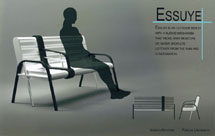 |
 |
Inculta Bench
$250 Honorable Mention
Zvezdan Nedelinovic
FUD Megatrend University
Belgrade, Serbia
The Inculta Bench is an aluminum extruded bench for outdoor use with a built-in squeegee to remove water on the surface. The judges thought the extensive use of extrusions paired with the novel feature of the seat squeegee and the use of multiple extrusions made this design a stand-out.
"How interesting that students from two different schools and living half a world away from each other came up with similar ideas," said Boyer.
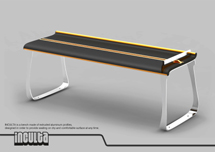 |
 |
REwater-mill
$250 Honorable Mention
Gorana Nesic
FUD Megatrend University
Belgrade, Serbia
The concept for this design is based on the use of natural resources, noted Gorana Nesic, a design student at FUD Megatrend University in Belgrade Serbia. The fin blades in the REwater-mill are attached to a central axel that turns the device in moving water. The central axel is then connected to a generator, which produces electricity. One more step in the development of this design would have made this a winner, according to the judges. However, "this hydro-power application is a fantastic use of the flexibility of extrusion to be joined in useful ways," said Boyer, which is why it was recognized with an honorable mention.
 |
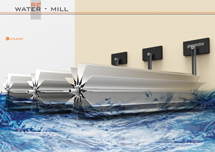 |
 -
-




 |
|